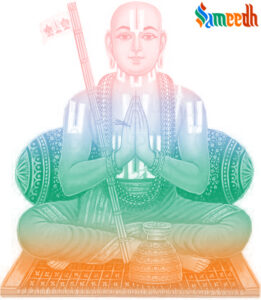Ramanujacharya, also known simply as Ramanuja, was a prominent Hindu philosopher, theologian, and spiritual leader who lived in South India during the 11th and 12th centuries CE. He is considered one of the most important figures in the Bhakti movement and a significant exponent of the Vedanta in Hindu philosophy.

Ramanujacharya made significant contributions to Hinduism through his philosophical teachings, religious reforms, and spiritual leadership. His teachings have had a profound influence on the development of Hinduism, particularly in the Vaishnavism tradition.
Here are some key aspects of Ramanujacharya’s contributions to Hinduism:
- Philosophical System: Ramanuja developed the Vishishtadvaita Vedanta (Qualified Non-dualism), a philosophical system that synthesized elements of Advaita (Non-dualism) and Dvaita (Dualism) Vedanta. In Vishishtadvaita, Ramanuja emphasized the concept of the individual soul (jiva) being qualitatively non-different from the Supreme Reality (Brahman), while also maintaining their distinct identities. This philosophical framework provided a comprehensive understanding of the relationship between the individual, the cosmos, and the divine.
- Bhakti (Devotional) Tradition: Ramanuja emphasized the path of devotion (bhakti) as a means to attain spiritual liberation (moksh). He advocated a loving devotion to the personal form of God, particularly Lord Vishnu, as the most effective way to realize one’s true nature and establish a direct relationship with the divine. Ramanuja promoted practices such as prayer, worship, chanting of sacred mantras (like the Vishnu Sahasranama), and surrendering to the divine will (prapatti) as integral aspects of the spiritual path.
- Interpretation of Scriptures: Ramanuja’s commentaries on foundational Hindu scriptures, such as the Vedanta Sutras, Bhagavad Gita, and Upanishads, provided insightful interpretations that aligned with the principles of Vishishtadvaita Vedanta. His commentaries elucidated the philosophical nuances of these texts, making them accessible to scholars and practitioners alike.His major works include the “Sri Bhashya” (commentary on the Brahma Sutras) and the “Gita Bhashya” (commentary on the Bhagavad Gita), among others.
- Equality and Inclusivity: Ramanuja emphasized the universality of divine grace and the accessibility of the spiritual path to all individuals, regardless of caste, gender, or social status. He actively opposed caste-based discrimination and encouraged the inclusion of all people in religious practices and spiritual communities.
- Establishment of Institutions: Ramanuja established monastic orders (mathas) and religious institutions to propagate his teachings and preserve the tradition of Vishishtadvaita Vedanta. These institutions served as centers of learning, spiritual practice, and community service, nurturing a vibrant intellectual and devotional culture.
- Legacy and Influence: Ramanuja’s teachings had a lasting impact on Hindu philosophy, theology, and religious practice. He established the Sri Vaishnava tradition, which remains one of the major sects within Hinduism, with a significant presence in South India and beyond. Ramanuja’s followers continue to venerate him as a revered saint and spiritual guide, and his philosophical insights continue to inspire scholars, devotees, and practitioners of Hinduism.
